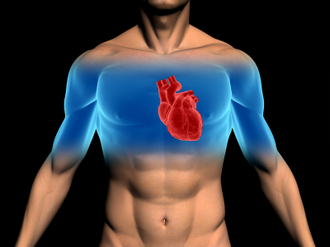Posted by Dr. Jack Sacks on April 30, 2018
Pericardial effusion occurs when there is an abnormal amount of fluid around the heart. The heart is normally surrounded by a thin membranous sac called the pericardium. The space between the pericardium and the muscle that is the heart is referred to as the perciardial space. Normal levels of pericardial fluid within the pericardial space are from 15 to 50 mL, or about 1-3 tablespoons.

An effusion, therefore, represents an abnormal accumulation of fluid in the pericardial space. Because of the limited amount of space in the pericardial cavity, fluid accumulation will lead to increased intrapericardial pressure and this can negatively affect heart function. Cardiac tamponade occurrs when there is a large enough pericardial effusion causing enough pressure to adversely affect heart function. This is an emergent life threatening condition.
Pericardial effusion symptoms may include difficulty breathing (dyspnea), shortness of breath when lying down (orthopnea), chest pain, cough, dizziness, low grade fever, rapid heart rate (tachycardia), and a feeling of anxiety
Pericardial effusion may be caused by:
-a disturbed equilibrium between the production and re-absorption of pericardial fluid,
-a structural abnormality that allows fluid to enter the pericardial cavity,
-inflammation of the pericardium (pericarditis)
-bacterial or viral infections
-injury to the heart from a medical procedure
-cancer
-heart attack
-autoimmune disorders
Unfortunately, pericardial effusion and cardiac tamponade may result from improper placement of a central venous catheter during a medical procedure involving an infant. This may arise when there is an inadvertent perforation into the pericardial space by the CVC and fluids are artificially infused into the space thereby causing the tamponade. Upon recognition of this situation, emergent removal of this fluid via a needle inserted through the chest wall and into the pericardial space (pericardiocentesis) can improve the infant’s chance of survival. It is suggested that routine radiography be performed to readily identify the CVC tip in all cases when these lines are placed into babies. Increased awareness of this complication may decrease the mortality associated with CVC related pericardial effusions.
Treatment depends on the underlying cause and the severity of the heart impairment. Pericardial effusion due to a viral infection sometimes goes away within a few weeks without treatment. Some pericardial effusions remain small and never need treatment. If the pericardial effusion is due to an autoimmune condition treatment with anti-inflammatory medications may help. If the effusion is compromising heart function and causing cardiac tamponade, it will need to be drained, most commonlyby a pericardiocentesis. In some cases, surgical drainage may be required by cutting through the pericardium creating what is referred to as a pericardial window.
